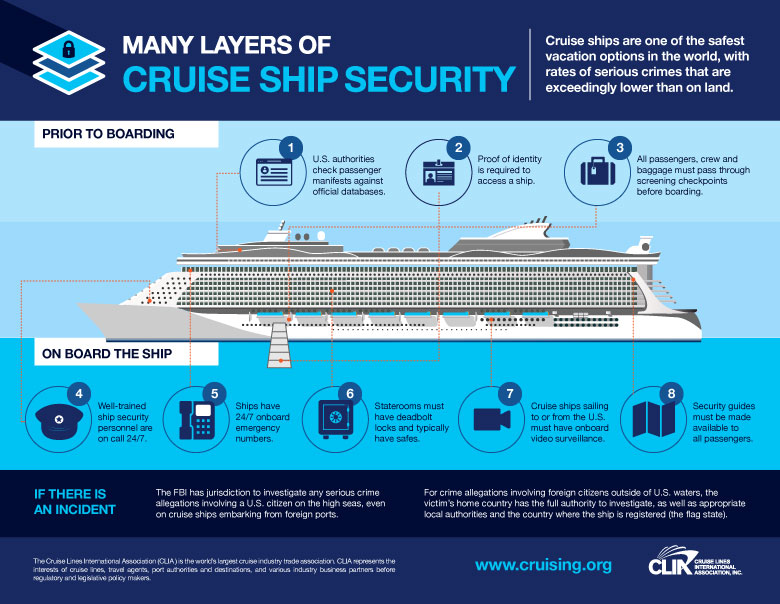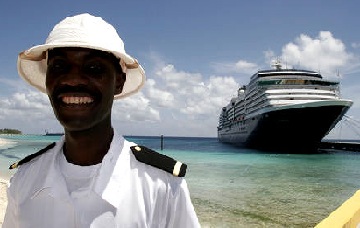Cruise ship security must fulfill international regulations and employ trained personnel. These measures ensure the safety and security of passengers and crew.
Navigating the vast waters aboard a cruise ship promises adventure and luxury, but it also requires stringent security to protect the passengers and crew against a myriad of threats. Cruise companies rigorously follow safety protocols mandated by the International Maritime Organization and the International Ship and Port Facility Security Code.
The core of a cruise ship’s security strategy hinges on employing a well-trained security team; this includes former law enforcement or military personnel with experience in managing complex security situations. Cruise lines also invest heavily in advanced security technologies like surveillance systems, controlled access to sensitive areas, and screening devices to detect contraband. Ensuring the security of thousands of passengers across international waters is no small feat—cruise lines must continually update and refine their security measures to counter evolving threats and maintain a secure, enjoyable environment for all on board.

Credit: landrykling.com
Quick Navigation
Evolution Of Cruise Ship Security
The safety of passengers and crew on cruise ships has always been paramount. Over time, the design and implementation of security measures have seen significant adjustments. Tighter regulations and technological advancements have played crucial roles in enhancing security procedures. Let’s delve into the progression of these safety protocols, from their origins to the modern-day features that keep us safe at sea.
Historical Context
Ocean voyages date back centuries, with security always a concern. In the past, pirates and sea marauders were the primary threats. Ships relied on manual lookouts and armed guards. The Titanic disaster in 1912 led to the first major international safety regulations, with a focus on lifeboats, iceberg monitoring, and ship structures. Over time, risks evolved, and cruise liners began implementing security checks similar to those used in airports.
Recent Security Enhancements
In recent years, cruise ship security has seen exponential advancements. Modern cruises include:
- Enhanced Surveillance: High-definition cameras and 24/7 monitoring ensure safety onboard.
- Rigorous Screening: Passengers and luggage undergo thorough screening before boarding.
- Improved Communication: Better systems enable quick response in emergencies.
- Crew Training: Regular security drills ensure crew readiness.
- Access Control: Keycard systems monitor and restrict entry to sensitive areas.
Beyond these measures, coordination with port authorities and international regulations ensure a unified approach to maritime security. These improvements have greatly enhanced passenger trust and safety during their seafaring adventures.
Understanding International Maritime Law
International maritime law governs the oceans and seas. It guides the operations and security of cruise ships. These laws ensure safety, peace, and environmental protection on international waters. Now, let’s explore the crucial international conventions and the challenges related to jurisdiction at sea.
International Conventions And Agreements
Cruise ships must follow specific rules. These are set by global agreements. International conventions like SOLAS and MARPOL set standards for safety and pollution prevention. Here’s a brief look at these key conventions:
- SOLAS (Safety of Life at Sea): Sets safety standards for ship construction, navigation, and emergency procedures.
- MARPOL (Marine Pollution): Addresses pollution from ships and includes six annexes focused on different types of ship-generated pollution.
- STCW (Standards of Training, Certification, and Watchkeeping for Seafarers): Ensures that seafarers are properly trained and certified.
- ISPS (International Ship and Port Facility Security Code): A framework to detect and deter threats to ships and port facilities.
Jurisdiction Challenges At Sea
At sea, jurisdiction can get complex. A ship may be registered in one country but sail through international waters. It can also enter the territories of other nations. Here are some challenges faced:
- Identifying which country’s laws apply can be hard.
- Cruise ships might have to comply with laws from multiple jurisdictions.
- Enforcing laws when a crime occurs on international waters can be tricky.
Flag states have some control over their ships. But enforcing laws when ships are in transit poses difficulties. The cooperation between nations is vital to navigating these legal waters.
Cruise Ship Security Personnel
Imagine setting sail across the blue seas without a worry in the world. To make this dream a reality, an elite team works tirelessly behind the scenes. This team is none other than the Cruise Ship Security Personnel. Their roles, training, and certifications ensure every passenger’s safety and creates an environment where fun and relaxation are the only concerns for guests on board.
Roles And Responsibilities
The primary mission of cruise ship security personnel is clear: maintain the safety of both passengers and crew. They stand as the vigilant guardians of peace and order on these floating cities. Here’s what they do:
- Patrol the ship to deter and detect any sign of security issues.
- Conduct security screenings for anyone boarding or disembarking.
- Manage crowd control to ensure the orderly conduct of passengers.
- Respond to incidents swiftly and effectively.
- Work closely with international port authorities.
Training And Certification Standards
Securing the high seas is no small feat. It calls for rigorous training and recognized certifications. Security personnel must meet the following standards:
| Training | Certification |
|---|---|
| Basic Security Training | STCW (Standards of Training, Certification, and Watchkeeping) |
| Crowd Management | Crisis Management and Human Behavior Certification |
| Suspicion and Surveillance Techniques | Security Awareness Certification |
| Emergency Response Drills | Maritime Security Operative (MSO) |
Certifications such as the STCW and MSO not only ensure a baseline of knowledge but also equip security personnel with the skills to handle complex situations. Continuous education and drills keep the team sharp and ready for any scenario, whether it’s a simple overboard situation or a major security threat.

Credit: www.cruiseshipjob.com
Passenger Safety Measures
Passenger Safety Measures are critical on a cruise ship. Like a floating city, a cruise must protect its guests. These measures are as essential as the lifeboats on deck. This post delves into how cruise ships keep passengers secure. Let’s explore the screening procedures and onboard security protocols.
Screening Procedures
- Check-In: Every passenger undergoes identification checks. These verify travel documents and tickets.
- Luggage Scans: X-ray machines check bags for dangerous items. This happens before boarding.
- Personal Screening: Similar to airports, metal detectors ensure guests don’t bring forbidden items onboard.
- Continuous Monitoring: Passengers may face random checks. This ensures safety on the journey.
Onboard Security Protocols
Safety on a cruise ship doesn’t end at boarding. Continuous efforts keep danger at bay. Here are the protocols that cruises follow:
Security Staff: Trained officers watch over passenger areas. They are ready to respond to incidents.Surveillance Cameras: These eyes run 24/7. They record public spaces for any suspicious activity.Access Control: Keycards limit entry to private quarters. Only authorized personnel and guests can enter.Safety Drills: Regular drills prepare everyone for emergencies. Passengers learn what to do and where to go.Medical Facilities: In case of health issues, clinics provide care. They have the tools and staff to handle emergencies.
Technological Innovations In Maritime Security
The seas are becoming smarter with the latest tech guarding cruise ships. With safety as a top priority, these breakthroughs are crucial for secure voyages.
Surveillance Systems
Onboard security begins with watchful eyes. Modern ships employ high-definition cameras. These cover every corner. Crews monitor them 24/7.
Recent developments have introduced 360-degree panoramic views. Motion detection helps to spot unusual activity fast. Night vision ensures safety even in darkness.
- Integration with AI – Systems that learn and alert potential threats.
- Real-time access – Captains and security heads watch live footage.
Advanced Screening Equipment
Screening keeps dangers off the ship.
Advanced scanners check luggage and people. They are swift and precise.
These machines see through bags and pockets. They detect metals, liquids, and other banned items.
| Equipment | Feature | Benefit |
|---|---|---|
| X-ray scanners | High-resolution imaging | Clear view inside bags |
| Metal detectors | Walk-through portals | Fast guest screening |
| Explosive Trace Detectors | Sensitive chemical sensors | Instant detection of threats |
These tools uphold strict security protocols. They maintain a fun, worry-free cruise experience.
Emergency Preparedness And Response
Emergency Preparedness and Response plays a crucial role in ensuring the safety of both passengers and crew aboard a cruise ship. In the face of unexpected events, a well-executed plan can mean the difference between order and chaos. The diligent preparation for emergencies involves systematic drills and comprehensive crisis management strategies.
Drill Requirements
Cruise ships uphold stringent drill requirements to maintain readiness for emergencies:
- Lifeboat drills for every passenger within 24 hours of embarkation
- Regular crew safety drills including fire and abandon ship scenarios
- Mustering practice to locate designated stations swiftly
These rehearsals instill confidence and ensure everyone knows their role during an emergency.
Crisis Management Plans
Crisis management plans are vital for addressing potential emergencies directly:
| Plan Component | Description |
|---|---|
| Communication Protocols | Details on alerting passengers and seeking external assistance |
| Evacuation Procedures | Steps for safe and orderly departure from the ship if necessary |
| Medical Contingencies | Actions taken to address injuries and provide care |
Effective crisis management plans anchor the safety strategies of cruise ships.

Credit: cruisejobdirectory.com
Frequently Asked Questions On Requirements For Cruise Ship Security
What Is Cruise Ship Security?
Cruise ship security refers to measures implemented to ensure safety and law enforcement at sea. Regulations require surveillance, trained personnel, and emergency protocols to protect passengers and crew from various threats, including piracy and onboard crimes.
How Is Cruise Ship Safety Regulated?
Cruise ship safety is regulated by international maritime law, specifically the International Ship and Port Facility Security (ISPS) Code. National laws and cruise line policies also dictate security protocols to safeguard the well-being of everyone onboard.
What Training Does Ship Security Staff Receive?
Ship security staff undergo rigorous training in emergency response, crowd control, surveillance, and law enforcement. These protocols are outlined by international maritime standards and customized by individual cruise lines to meet their specific security needs.
Are There Security Drills On Cruise Ships?
Yes, cruise ships conduct regular security drills to ensure preparedness. Crew members and passengers participate in these exercises to practice procedures for various emergency scenarios, including man-overboard situations and security breaches.
Conclusion
Navigating the vast blue expanses safely requires robust cruise ship security measures. Compliance with stringent regulations ensures passenger, crew, and vessel safety. Regular training, advanced technology, and thorough procedures are pillars of this security framework. Embracing these requirements not only guards against threats but also enhances the overall cruise experience, instilling trust and peace of mind for everyone on board.



